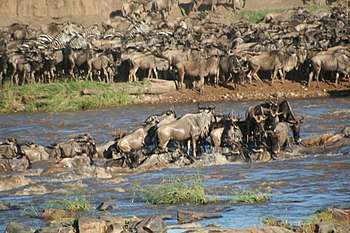Migration (ecology)

Wildebeest migrating in the Serengeti
Migration, in ecology, is the large-scale movement of members of a species to a different environment. Migration is a natural behavior and component of the life cycle of many species of mobile organisms, not limited to animals, though animal migration is the best known type. Migration is often cyclical, frequently occurring on a seasonal basis, and in some cases on a daily basis. Species migrate to take advantage of more favorable conditions with respect to food availability, safety from predation, mating opportunity, or other environmental factors.[1][2] Types of migration include:
- Animal migration, the physical movement by animals from one area to another
- Bird migration, the regular seasonal journey undertaken by many species of birds
- Reverse migration, a phenomenon in bird migration
- Fish migration, the regular journey of fish
- Insect migration, the seasonal movement of insects
- Lepidoptera migration, the movement of butterflies and moths
- Bird migration, the regular seasonal journey undertaken by many species of birds
- Diel vertical migration, a daily migration undertaken by some ocean organisms
See also
- Animal navigation, abilities used by animals to navigate
- Human migration, physical movement by humans from one area to another
- Plant migration, or seed dispersal, the movement or transport of seeds away from the parent plant
- Forest migration, the movement or transport of large seed plant dominated communities in geographical space over time
References
- ↑ "Migration and dispersal". Wrexham Glyndŵr University. Archived from the original on October 10, 2017.
- ↑ Dorst, Jean P. "Ecological Significance of Migration". Encyclopedia Britannica. Retrieved 7 December 2017.
This article is issued from
Wikipedia.
The text is licensed under Creative Commons - Attribution - Sharealike.
Additional terms may apply for the media files.